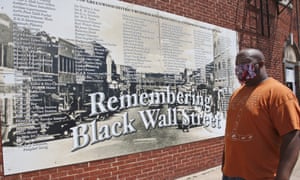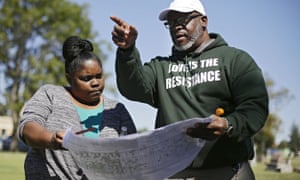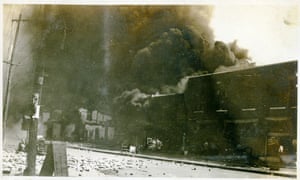Oklahoma
Planned visit puts spotlight on massacre, where 300 black people were killed in one of the worst single acts of race violence in the US

Photograph: Sue Ogrocki/AP
Donald Trump’s decision to stage a campaign rally in a sports stadium in Tulsa, Oklahoma, is spurring a renewed push for reparations for the racial massacre that devastated the city’s black community just 10 blocks away from where the president will be speaking on Saturday.
Trump’s appearance at the indoor BOK Center in downtown Tulsa is generating fears that it could spread coronavirus and exacerbate racial tensions amid the overwhelmingly peaceful protests following the death in police custody of George Floyd.
But his scheduled visit is also providing a boost to a justice movement that has coalesced around the 1921 massacre that struck a thriving area of the city known as “Black Wall Street”.
“The visit is galvanising people,” said Damario Solomon-Simmons, a civil rights lawyer who represents the last known survivor of the massacre living in Tulsa. “We are all very concerned about Trump coming to Tulsa as he creates violence and intimidation among his supporters, but on the other end it has put the spotlight on the massacre.”
The Tulsa race massacre is widely considered to be one of the worst single acts of racial violence in US history. It erupted over a 24-hour period on the night of 31 May 1921.
The trigger of the attack was a call to lynch a black man for assaulting a white woman based on flimsy evidence. The wider context was that by the 1920s Greenwood had become one of the most vibrant black communities in the country boasting many successful businesses – hence its moniker “Black Wall Street”.

With the complicity and even assistance of local authorities and police, a white mob descended on Greenwood and unleashed violence on its African American residents. Houses were set alight from the ground and from the air, with planes dropping incendiary devices. By the end of the carnage 35 square blocks of the district had been razed. The precise number of black people who died may never been known – a search for possible mass graves has been delayed by the pandemic – but it is thought to be at least 300.
As Trump’s visit approaches, a petition is gathering pace that calls on the city of Tulsa and state of Oklahoma to make full reparations to survivors of the massacre and their descendants. It also demands compensation for the Greenwood community where the horror took place and its current institutions including schools, businesses and churches.
A number of legislative and legal moves are also being considered, including an effort to persuade Congress to lift the statute of limitations from any reparations claim. “At this time all options are being reviewed – legal and otherwise,” said Solomon-Simmons.
Renewed impetus has also come from Human Rights Watch which has added its advocacy muscle to the campaign. The organization has released a 72-page report that argues that reparations for Tulsa is a matter of international human rights.
Proponents of reparations say the mass lynching in 1921 was just the start of a tragic story of the conscious undermining of the black community. Over the past century, efforts to rebuild Greenwood as a buoyant area for black enterprise have repeatedly been foiled through a combination of zoning laws, building restrictions, red-lining and urban renewal – which black Tulsans have taken to calling “black removal”.
Several highways were also constructed directly through the area, splintering it into less viable fragments.
As a result, the modern city of Tulsa struggles under the burden of stark racial disparities. The Human Rights Watch report estimates the poverty rate for black Tulsans is almost three times that of whites, unemployment more than double, and life expectancy 11 years cut short – while black Tulsans live on average about 70 years, white Tulsans live 81 years.

Those searing disparities are critical in making the case for reparations, the movement’s supporters believe. Solomon-Simmons calls the aftermath of the 1921 violence a “continual massacre”.
He said: “I think people are starting to understand that Tulsa as a city, that the United States as a nation, can’t move forward until we are honest not only about the 1921 massacre but about how things have gone in the last 100 years. The oppression didn’t end in 1921 – it continued over the past century.”
Solomon-Simmons’ client, Lessie Benningfield Randle, is one of only two known survivors of the massacre and the only one still in Tulsa. She was five or six when the mass lynching happened, and recalls hearing the shooting and white men coming to her grandmother’s house and setting it alight.
She fled the city into the surrounding countryside, passing bodies in the streets as she did.
Her desire in terms of reparations, her lawyer said, was for a pension – not for her, as she is now 105 years old, but for her descendants. “They were never able to get back on their feet, never able to recover,” Solomon-Simmons said.
No one has ever been held accountable for the events of 1921. A commission set up in 2001 to look into the massacre recommended reparations for survivors and descendants, but the city ignored it.
Two years later a team of prominent civil rights lawyers sued Tulsa, its police department and the state, demanding restitution. But the suit was dismissed in the courts and the US supreme court declined to step in.
In addition to compensation, local reparations advocates backed by Human Rights Watch want to see targeted investment in health services, education and economic development for black Tulsans who today live mainly in economically-deprived North Tulsa. They are also pushing for a memorial to mark the massacre as it approaches its centennial next year.




